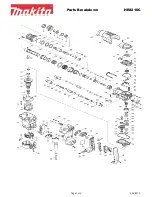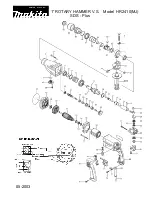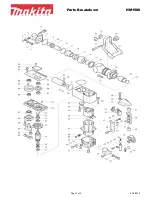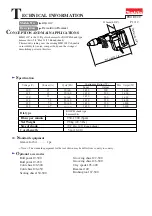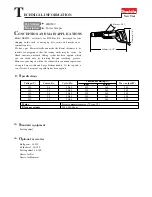
5
2. General Health & Safety Guidance
2. General Health & Safety Guidance - cont.
7. Remove adjusting keys and wrenches
• Ensure that all adjusting wrenches and keys are removed
before switching the machine ‘ON’. There is a risk of
severe personal injury or damage to the machine from
airborne objects.
8. Before switching the machine ‘ON’
• Clear the machine table of all objects (tools, scrap
pieces etc.)
• Make sure there is no debris between the work piece and
the table / work support.
• Ensure that the work piece is not pressed against, or
touching the saw blade or cutting tool.
• Check all clamps, work holding devices and fences to
ensure that they are secure and cannot move during
machining operations.
• Plan the way that you will hold and feed the work piece
for the entire machining operation.
9. Whilst machining
• Before starting work, watch the machine while it runs.
If it makes an unfamiliar noise or vibrates excessively,
switch the machine ‘OFF’ immediately and disconnect it
from the power supply. Do not restart until finding and
correcting the source of the problem.
10. Keep the work area clear
• Working clearances can be thought of as the distances
between machines and obstacles that allow safe
operation of every machine without limitation. Consider
existing and anticipated machine needs, size of material
to be processed through each machine and space for
auxiliary stands and/or work tables. Also consider the
relative position of each machine to one another for
efficient material handling. Be sure to allow yourself
sufficient room to safely operate your machines in any
foreseeable operation.
• Cluttered work areas and benches create the risk of
accidents. Keep benches clear and tidy away tools that
are not in use.
• Ensure that the floor area is kept clean and clear of any
dust and debris that may create trip or slip hazards.
11. Consider the work area environment
• Do not expose the machine to rain or damp conditions.
• Keep the work area well lit and ensure that there is
artificial lighting available when there is insufficient
natural light to effectively light the work area. Lighting
should be bright enough to eliminate shadow and
prevent eye strain.
• Do not use the machine in explosive environments eg. in
the presence of flammable liquids, gases or dust.
• The presence of high levels of dust created by machining
wood can present a risk of fire or explosion. Always use
dust extraction equipment to minimise the risk.
12. Keep other persons away (and pets)
• The machine is designed to be used by one person only.
• Do not let persons, especially children, touch the machine
or extension cable (if used) and keep visitors away from
the work area.
• Never leave the machine running unattended. Turn
the power supply off and do not leave the machine
unattended until it comes to a complete stop.
• If the work area is to be left unattended, all machinery
should be switched ‘OFF’ and isolated from the mains
power supply.
13. Store machines safely when not in use
• When not in use, machines should be stored in a dry
place, out of reach of children. Do not allow persons
unfamiliar with these instructions or with the machine to
operate it.
14. Do not overreach
• Choose a working position that allows your body to
remain balanced and feed the work piece in to the
machine without overreaching.
• Keep proper footing and balance at all times.
15. Electrical supply
• Electrical circuits should be dedicated to each machine
or large enough to handle combined motor amp loads.
Power outlets should be located near each machine so
that power or extension cables are not obstructing high-
traffic areas. Observe local electrical guidelines for proper
installation of new lighting, power outlets, or circuits.
• The machine must be connected to an earthed
power supply.
• The power supply must be equipped with a circuit
breaker that provides short circuit, overload and earth
leakage protection.
• The voltage of the machine must correspond to the
voltage of the mains power supply.
• The mains plug fitted to the machine should always
match the power outlet. Do not modify the plug in any
way. If a replacement plug is required it should be fitted
by a competent person and of the correct type and rating
for the machine.
• If you are unsure about any electrical connections always
consult a qualified electrician.
Summary of Contents for WG250
Page 37: ...37 14 Parts Lists Diagrams ...





















